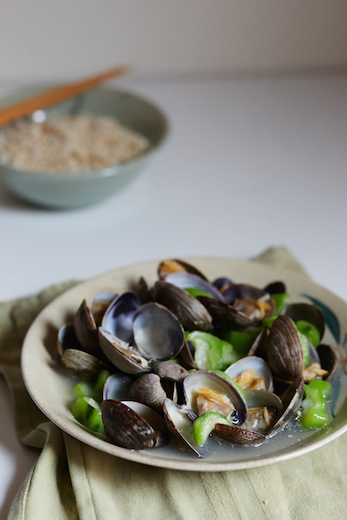There were several glazed ceramic bowls meant for serving but not mixing, two pots and one cooking pan — not even a wok, but a shallow skillet. That’s all I had to work with in this Taiwanese architect’s sleek kitchen, where I was preparing a meal for eight cultured, artistic guests in his Japanese-style home, nestled in the foothills of Yangmingshan mountain just outside Taipei.
We’d taken winding roads through the forest and the rain to get there, ready for a quiet home-made dinner away from the city below. All eyes were on me, the talked-up Brooklyn guest “chef” showing off my so-called expertise in Taiwanese food. I had gotten myself into this situation on one of the last nights of a three-week trip to Taiwan, my second trip to this Asian island state researching and photographing a cookbook on Taiwanese food.
My previous cooking adventure in the country, just a few days before, involved a large family of three generations who welcomed me into their home to help prepare and feast on a multicourse meal. Together, these aunts, grandmothers and daughters worked seamlessly to make a fragrant family banquet: three cup squid with basil leaves, chilled oysters sprinkled with cilantro and crushed peanuts, whole shrimp flash-sautéed in a wok with crispy aromatics, pan-fried rice noodles and many more traditional Taiwanese dishes that I was mastering for my book. It was reminiscent of my family dinners in New Jersey, where my Taiwanese mother and uncle took turns at the stove while I lingered beside them. It was also the type of communal cooking atmosphere that I crave in Brooklyn, ever since I moved across the Hudson straight from college 10 years ago. But I had a feeling this was not to happen after I volunteered to cook for Mr. Jiang — the architect whose elegant and understated kitchen was so deprived of basic kitchen gear — and a motley crew of friends I had made in the city during my travels.
Like most metropolises, the northern Taiwanese city of Taipei is one of astounding contrasts and contradictions: glitzy high-rise buildings next to ramshackle alleyways with street peddlers selling fried tofu; high-fashion handbags that brush against baskets of produce for sale on the same streets; hipster students taking selfies on cellphones in parks alongside the elderly playing mahjong; curving roads leading to lush, leafy mountains and coastal promenades just outside the city limits.
So, too, the food of Taiwan is multifaceted. Thanks to its subtropical climate, there are fresh fruits and vegetables in many colors; thanks to its heritage as a melting-pot of Chinese regional traditions, with a dose of Japan from the 50 years spent under that country’s colonial rule, the flavors used to prepare them are rich and diverse. My joy in finding the ever-fascinating juxtapositions of Taiwanese food led me to Yong Kang Road, home to Din Tai Fung, famous for its Michelin star and Shanghai-style soup dumplings, and Tu Hsaio Yueh, the northernmost outpost of a famous Danzai noodle shop, to name but two.
There I also stumbled into a small store owned by a woman who went by the nickname of Xiao Wanzi, or “little ball.” She was aptly named — an energetic, absolutely adorable woman in her late 30s or early 40s. Her store sold mostly antiques — tea kettles, hand-made pottery, musical instruments — and gifts like handmade chopsticks or CDs of Taiwanese folk musicians. I have never seen anything purchased in Xiao Wanzi’s shop. Instead, it seemed more like an informal teahouse for her many friends who would drop by to sit down and talk for hours at length — musicians, sculptors and architects, and I gathered that many of the things Xiao Wanzi “sold” were made by her friends.
(On my first visit there, I felt it only right to buy something after enjoying her hospitality for hours. But it seemed like finding a calculator and receipt pad to ring up the bamboo pencils and antique-print postcards I bought was something of an inconvenience.) Sharing a block with hip Japanese restaurants, ice cream parlors and youthful clothing boutiques, Xiao Wanzi’s store was like a quiet oasis of more authentic Taiwanese culture. Pete, my photographer, and I went there often, and met many of the folks now gathered at Mr. Jiang’s, who helped us explore their country for our culinary purposes.
Those were the guests who now chatted over glasses of good European wine, while I was thinking fast about how dinner would all be prepared. The chicken and fresh bamboo shoot soup would be started first: I chose the larger of the two pots to sear the bony bird backs I’d purchased at the produce day market hours before, adding slabs of ginger and whole garlic cloves before covering them with water. Then, the steamed bitter melon, stuffed with lots of chopped chives and ground pork marinated with soy sauce and sesame oil.
Xiao Wanzi approached to help, and intuitively understood the dish, as it was a classic Taiwanese preparation. But there was no steamer in the house in which to make it. I thought back to all the times I had made renegade steaming contraptions in Brooklyn, like the time I made Asian steamed buns for a cook-off on the street outside Kelso Brewery in Clinton Hill using disposable aluminum chafing dishes with layers of foil punctured with holes. So I found an ancient rice cooker in Mr. Jiang’s cabinet that he said probably didn’t work anymore, filled it with a small pool of water and plugged it in. The metal on the bottom of the cooker started getting hot. A plate was situated atop a bowl inside the device and, one small plateful at a time, that stuffed bitter melon was steamed. The pan-fried okra with garlic, chilies and fermented black beans should have been no big deal: whole pods, sautéed with their aromatics in the smaller pot, were given a splash of water to braise through until tender. But I had to repeat the task about four times to cook them all, since the larger pot was occupied with the soup.
I used the same pot to cook the clams braised with loofah squash (a squishy, ridged, zucchini-like gourd commonly eaten throughout the island). This dish is decidedly simple, a sort of yin to the yang of so many heavily seasoned dishes featuring clams in Taiwan. The squash is allowed to become soft, cooked only with garlic and the juices of the bivalves as they open. Once braised, the squash absorbs the flavors of the sea and serves as vessels for its flavor, much like the meat of clams themselves.
Then it was time to make the omelet, a quintessential peasant dish of Taiwanese fame, studded with dried, pickled radish nibs. By then, our guests were hungry; they were also excited that I had chosen such a familiar homestyle dish, and all knew exactly how it was supposed to turn out. Dried radishes are a rustic delicacy that are found in every market and are used in many ways in Taiwan: daikon radish is first salted and then hung to dry until shriveled and golden in color, its flavor sweet and mostly salty. In this dish it’s finely chopped, enveloped into beaten eggs for a quick and flavorful portion of protein and vegetable to eat with a bowl of rice.
The resulting omelet should be fluffy and have height; and it should be golden-brown on each side, with nearly all of the radish pieces having been cooked with direct contact on the pan so as to be as crisp. In theory, it should take no longer than 20 seconds to cook in a pool of oil in a searing-hot, well-seasoned wok. I didn’t have that, so I brought out the skillet in order to attempt the skillful feat of beating the eggs directly into the chopped radish bits already in the wok, letting them cook just until swirls of browned crust form at the bottom, and then swiftly flipping the whole thing over to brown the opposite side. I got the pan I had very hot with oil (supplied by a late-arriving guest, as Mr. Jiang did not have any in his pantry) and slipped in the radishes, stirring them with chopsticks for no longer than two seconds before pouring in the eggs, then whisked it all furiously with my chopsticks again until the eggs were almost set.
When it came time to turn the omelet, everyone watched, holding their breath. Using the only spatula I could find and a jerk of my hand, I flipped it over. It landed with a brief splat: The cooked side was visibly marbled and layered from the whisking, as it should be. It was intact. And I dare say that this simple dish, probably the homeliest on the table, was the best part of the meal.
Cathy Erway’s new book, The Food of Taiwan, will include recipes from the story above (as well as many others) and will be published in March 2015 by Houghton Mifflin Harcourt. Can’t wait till then? We’ve got her recipes for Taiwanese Dried Radish Omelette and Taiwanese Braised Clams with Loofah Squash.
Photo credits: Pete Lee and Lauren Volo



